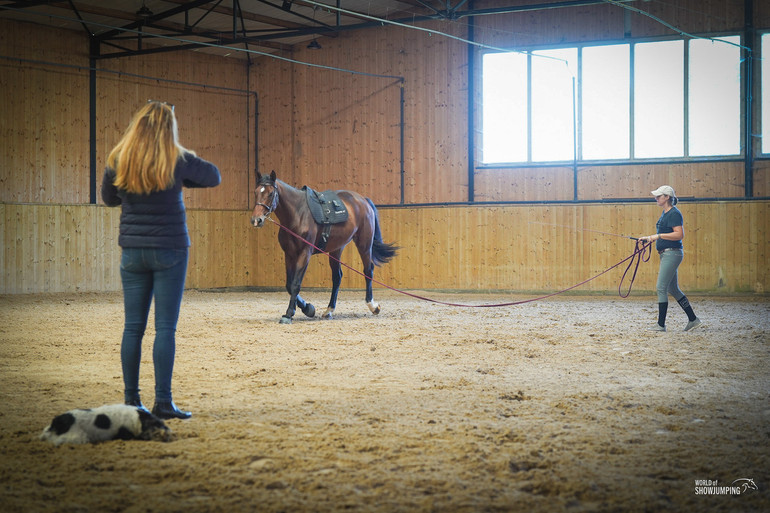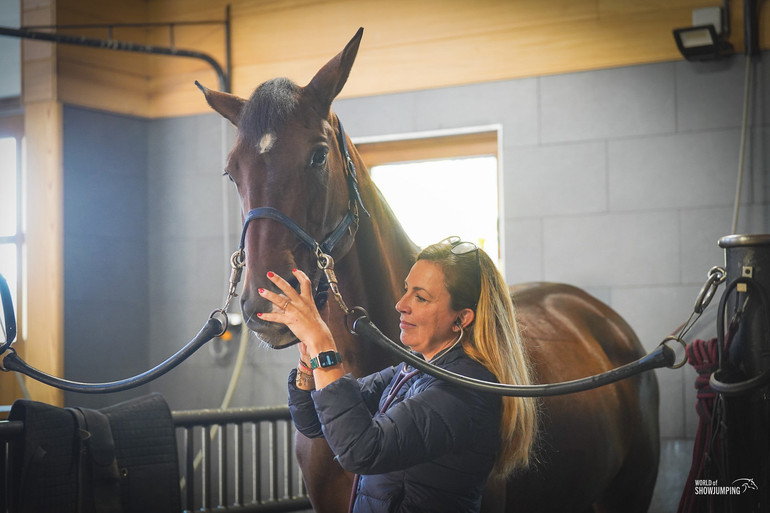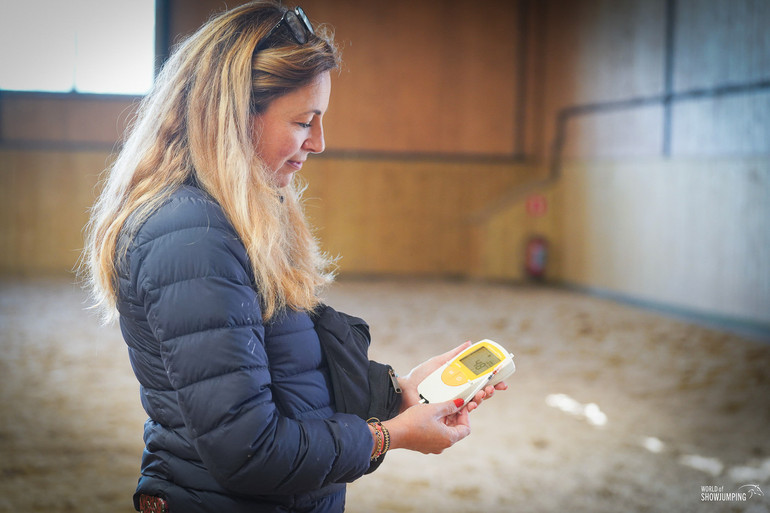Text © World of Showjumping
“Exercise monitoring is a very good way of making sure we are staying in the green zone and do not push the horses beyond their capacity,” Emmanuelle Van Erck Westergren – the president of the Belgian Equine Practitioner Society (BEPS) – tells World of Showjumping. “It is still not widespread, even though the level of fitness we ask from our horses is getting higher; our horses need to compete more intensely over longer periods of time. Before there was a seasonality to the shows, whereas now, if you want to compete every week, you can. There is seldom a period of time that allows a horse to fully recover. Horses do get easily fit if they are trained properly, but it is essential to make sure they are kept at a good level of fitness and not over-trained.”
Getting ready for a major championship
“If you have a horse that has a basic level of fitness, getting them ready in terms of fitness for something like a major championship – like the 2024 Paris Olympics as an example – takes about three to six months,” Van Erck Westergren says. “It can feel early to start planning for Paris now, but the longer ahead you plan, the more time you have to adapt to unexpected factors. You will also have time to rest the horse more if needed. Maybe the conditions at a competition were other than planned, courses were harder, the weather was hot and humid – all these variables would create a higher burden on the horse than expected, resulting in more rest needed. Individual response is important as well; if you have a horse that you have identified a problem with, you need to work around that problem and make sure that you are maintaining fitness but not overtraining the horse in regard to that particular issue.”
You need a baseline measurement; where is your horse at right now in terms of fitness
“Like humans, horses are all very different in their shapes and sizes and in their response to training,” Van Erck Westergren continues, pointing out the importance of making an individual conditioning plan for each horse. “To start with, you need a baseline measurement; where is your horse at right now in terms of fitness? What I usually do is to test the horses every two to three months, starting with a baseline test to see where they are starting from, and then comparing them to a group of other horses as they progress. I do a simple test where I look at a horse walk, trot and canter and use sessions of two minutes, monitoring the heartrate and looking at their recovery. I also measure lactates, which allows me to see how a horse uses its oxygen; if it has enough cardiorespiratory capacity or not.”
“During an active trot, a normal horse should have a heartrate between 85 and 95. Anything above that could be a sign of stress or poor distribution of oxygen due to either a heart or a lung problem. Horses that exercise in hot and humid weather would have higher heartrates as well. During canter, a normal heartrate would be between 95 and 110, and if the horse is feeling well, is well balanced and fit, those values are going to be more towards the 95. Instead of having a steady heartrate, a rate that only increases is usually a sign of pain and discomfort, while a maximum heartrate for race horses in full canter is between 210 and 250.”
“The fitter a horse is, the lower the heartrate, the lower the lactates for the same level of exercise. It is also a very good way of monitoring a horse’s response to treatment, therapy or rehabilitation; it is a simple and objective way of seeing if it is safe to return to competition or not. Horses respond to training quite quickly; within four to six weeks, you should be able to measure some significant differences. However, there is a difference in bringing a horse to optimal fitness and maintaining them there. If you have a fit horse and you have to take a break, horses do not detrain very easily; horses can stay at a good level of fitness for over a month even if they are not doing much – as long as they were fit before.”
Make an individual plan
Making a conditioning plan starts with evaluating the individual horse and understanding where you currently are at. “What age your horse is, where it is starting from, whether it is fit to compete – those are the questions you need to answer,” Van Erck Westergren explains.
“While horses need to be turned out every day, it does not mean they need to work every day; they simply need to get out and move. If you put a tracker on horses out in the wild, or even in a very large field, they will walk from 16 to 20 km per day. Therefore, if a horse is in a box and you take it out only for an hour per day, that is not going to be sufficient exercise on any level. Turning horses out every day is really important, and doing consistent work is essential for their muscles. If you only do bursts of intense exercise and then nothing, that exposes the muscles to damage and can create muscular conditions.”
If a horse is in a box and you take it out only for an hour per day, that is not going to be sufficient exercise on any level
Part of making a conditioning plan is to consider what you have available in terms of facilities to train; do you have just a simple indoor or outdoor, are there hills or a possibility of going to the seaside? “Access to good facilities can help a rider improve the fitness of their horse in a more varied way than only doing flatwork,” Van Erck Westergren points out. “The training facilities you have available are going to determine what type of sessions you should do, and the time frame during which you should see improvement. It is going to be easier to improve a horse that has an access to a canter track versus a horse that only has an indoor – on a canter track you can let the horse increase its heartrate more easily as you don’t have to turn every 60 meters.”
Normal behavior or a sign of an underlying issue?
 “There are wearable devices that we can use for horses, and if riders start to show interest in how their horse responds to training by looking at their heartrate during exercise, they are going to realize how important and how sensitive that marker is in relation to a horse’s fitness and health,” Van Erck Westergren says.
“There are wearable devices that we can use for horses, and if riders start to show interest in how their horse responds to training by looking at their heartrate during exercise, they are going to realize how important and how sensitive that marker is in relation to a horse’s fitness and health,” Van Erck Westergren says.
While some riders have very good knowledge and appreciation of how their horse behaves during exercise, certain factors are often overlooked, Van Erck Westergren points out. “Sometimes you have horses that aren’t comfortable; you can see them breathe heavily, kick or swish their tales or jump in an asymmetric way,” she explains. “And while all these are cues that there might be something going on physiologically, riders often label them under ‘normal behavior’ or their horse ‘always having been that way’. All these “normal behaviors” can be a sign of physical discomfort linked to an underlying issue, even lameness. Some riders are not very sensitive to these cues, and therefore using a heartrate monitor is an excellent way of seeing if it actually is about the behavior or not. Also, it is an objective way of comparing yourself to other athletes, and that is how you progress; if you want to win a competition, it is important to know where you are in terms of fitness when it comes to your competitors.”
A heartrate monitor is an excellent way of seeing if it actually is about the behavior or not
“Another problem that we see is a horse that isn’t doing enough in terms of cardio,” she continues. “Riders often do flatwork without a very high heartrate, and that is fine for a certain level. However, if you are trying to improve the fitness of your horse, you do have to increase the heartrate in order to make the body respond to training. That can be done over jumps, but it can also be done on a canter track. Going for canters adding increasing speed with a brief recovery in between allows you to do more without putting too much strain on the horse’s skeleton or tendons. You could also do work in the water, either on a water treadmill or by going to the beach or you can train on hills – all these options are going to create fluctuations in the heartrate, which are needed for improving fitness.”
Monitor data, detect issues earlier
“There are wearable devices that we can use for horses, and if riders start to show interest in how their horse responds to training by looking at their heartrate during exercise, they are going to realize how important and how sensitive that marker is in relation to a horse’s fitness and health,” Van Erck Westergren says. “If you are used to measuring your horse’s heartrate, you will see that if you horse is healthy and well trained, over time their heartrate will be exactly the same during an exercise. And if you start with a horse that has a low level of fitness, you can easily follow the horse’s progress; for the same amount of work, the heartrate is going to go down, which is a sign of the horse adapting adequately to your conditioning program. On the contrary, if your horse has an underlying disease or has pain or discomfort – maybe due to lameness or another issue that you cannot really feel, or due to a cardiorespiratory issue – the heartrate will start to shift."
Heartrate is a much more sensitive signal than the rider’s feeling or any other test a vet can do
"Heartrate is a much more sensitive signal than the rider’s feeling or any other test a vet can do; it is a very good way of monitoring horses. If you monitor sessions every week or even every two weeks, you will already see differences in the way your horse responds after a period of four to six weeks. If you have done things correctly, your horse should have a lower heartrate and a quicker recovery, going back to its resting heartrate.”
“However, some of the monitors that are commercially available, have not been properly validated, meaning that they claim they measure heartrate but the way that they monitor the signal of the heart is not accurate enough, or the way speed is measured is not reliable,” Van Erck Westergren says, highlighting that caution is needed when choosing a device.
“We have had horses referred to us because they had high heartrates, but in the end, it was just the monitor that was dysfunctional and not validated. Therefore, when you choose a device, make sure it has been tried and tested," Van Erck Westergren says.
"The devise that I work with, was initially designed for racehorses, so that the trainers would get indications of the speed and stride, but it also includes heartrate. We have worked with the engineers to include the EKG and that gives us an extra parameter, which is very sensitive to signs of discomfort in the horse. Prior to a horse having an injury, we can usually see abnormalities on the EKG and pick up arrhythmias. When trainers use these systems, and see a horse not responding to exercise as it should, or they feel there is something off, they can refer the data to us and we can have a look. So instead of being called as a vet because a horse has a problem, we can monitor horses in their training on a distance and pick up things much earlier. This way, we can also avoid having a horse compete – and in best case scenario, have poor performance, or in worst case scenario, sustain an injury because of an underlying issue that had not been detected. The more frequently horses are tested, the more sensitive you are in profiling them. A horse that is healthy and fit, is very consistent in its data – as soon as the data shifts away from the normal profile, the more likely you are to have an underlying issue.”
Dr Emmanuelle Van Erck Westergren is the president of the Belgian Equine Practitioner Society (BEPS). She graduated from the Ecole Nationale Vétérinaire de Maison Alfort (France) and did a PhD on respiratory functional tests in horses at the University of Liege (Belgium). She is a diplomate of the European College of Equine Internal Medicine (ECEIM). Emmanuelle founded her specialized referral practice, the Equine Sports Medicine Practice based in Belgium and consults internationally.
25.10.2023 No reproduction of any of the content in this article will be accepted without a written permission, all rights reserved © World of Showjumping.com. If copyright violations occur, a penalty fee will apply.














